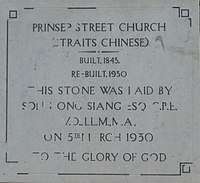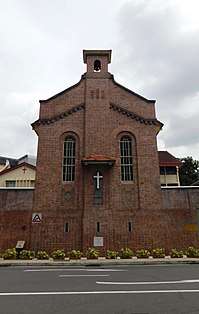Prinsep Street Presbyterian Church
| Prinsep Street Presbyterian Church | |
|---|---|
 View of church from Prinsep Street | |
 Prinsep Street Presbyterian Church | |
| 1°18′06.1″N 103°51′07.3″E / 1.301694°N 103.852028°ECoordinates: 1°18′06.1″N 103°51′07.3″E / 1.301694°N 103.852028°E | |
| Location |
77 Prinsep Street Singapore 188649 |
| Country |
|
| Denomination | Presbyterian |
| Website |
www |
| History | |
| Former name(s) |
|
| Founded | 1843 |
| Founder(s) | Rev. Benjamin P. Keasberry |
| Architecture | |
| Heritage designation | National Monument of Singapore [1] |
| Designated | 12 January 2000 |
| Architect(s) | Swan and Maclaren |
| Style | Romanesque |
| Administration | |
| Synod | Presbyterian Church in Singapore |
| Clergy | |
| Senior pastor(s) | Rev. Darryl Chan |
| Designated | 12 January 2000 |
The Prinsep Street Presbyterian Church (Chinese: 布连拾街长老会磐石堂) is located on Prinsep Street within the Central Area of Singapore's central business district. It is approximately 350 metres from Rochor MRT Station. [2]
The church was founded by Reverend Benjamin Peach Keasberry in 1843. It was previously known as the Malay Chapel. In 1930, the chapel was replaced with the present Romanesque-style building. It was gazetted a national monument by the National Heritage Board on 12 January 2000. [3]
History
In 1839, a Presbyterian minister of the London Missionary Society, Reverend Benjamin Peach Keasberry (1811-1875), started an elite boarding school for Malay boys in Rochor, with an attached printing press. Some of his pupils were thought to have been of royal descent.
In 1843, Rev. Keasberry was able to raise sufficient funds to build a small chapel on Princep Street for outreach to the Malays.
The church was first named the Malay Chapel in recognition of the reverend's contribution to the Malay community. It was also known as Greja Keasberry or Keasberry's Church. The missionary Samuel Dyer preached the first sermon at the Malay Chapel in 1843.[4]
In 1847, shortly after the inauguration of the church, the London Missionary Society left Singapore for China, leaving Keasberry to carry the torch alone. This he did stoically, until his death on 6 September 1875. To honour him, an engraved stone plaque was placed on his grave in Bukit Timah by his former student Maharajah Abu Bakar of Johore.
In 1885, the Presbyterian community, funded by Singaporean merchants living in London, bought the building from the London Missionary Society. It was renamed Prinsep Street Church. As the purchase was initiated by Reverend J.A.B. Cook, the missionary in charge of the English Presbyterian Church, Prinsep Street Church now came under its administration.
The Straits Chinese congregation held services at the church, as did the Teochew Tek Kha Group or Kandang Kerbau Market Group, and the pupils of Sophia Cooke's Chinese Girls' School. The Tek Kha Group established their headquarters at Prinsep Street Church and remained there until 1929 when their own church building which is also on Prinsep Street (diagonally oppopsite) and now known as Singapore Life Church, was ready.
As early as 1901, plans were made for a new church. On 5 March 1930, Song Ong Siang, who later became the first Malayan Chinese to be knighted, laid the foundation stone. The church was officially opened and dedicated on 4 February 1931.

In November 1931, upon joining the Synod of the English Presbytery, Prinsep Street Church was eligible to include "Presbyterian" in its name. Thus, the Straits Chinese Presbyterian Church was born.
The Straits Times, 8 June 2017. [5]
By the early 20th century, the area around the church became densely populated. This led Scotsman James Milner Fraser to start the 1st Company of the Singapore Boys’ Brigade in the church. Its formation in 1930 led to a large number of young people joining the church. In 1950, the 7th Girls' Brigade Company was formed in the church, drawing the students from the Singapore Chinese Girls' School and the Convent of the Holy Infant Jesus (CHIJ) in Victoria Street.[6]
During the Japanese Occupation, the church was damaged by shrapnel and mortar shells. Reverend Gibson, who had been incarcerated by the Japanese during World War II, repaired the church upon his release in 1947.
In 1953, the first full-time local pastor, Reverend John J.K. Lu, was appointed. The post-war years saw a fall in the Straits Chinese congregation and the church was renamed Prinsep Street Presbyterian Church in 1956. Its non-Straits Chinese congregation grew rapidly and, in the mid-1980s, a four-storey building was erected to accommodate their needs.
In the 1960s, the Church operated a kindergarten in mornings.
The church was gazetted a national monument by the National Heritage Board of Singapore on 12 January 2000. [7][8]
Architecture
The Prinsep Street Presbyterian Church was designed by architect C.J. Stephens of Swan and Maclaren. Its notable features are the deep red bricks and raised brickwork on the tower and belfry.
At the front of the church, lightly modelled brickwork rises high in gable formation expressing the shape of the roof and culminating in a bell tower, now housing a loudspeaker. Buildings within the enclosure are all rendered and painted.
Sunday Services
| SUNDAY SERVICES | ||
|---|---|---|
| TIME | LANGUAGE | VENUE |
| 8.00 AM | English | Level 4, Multi-purpose hall |
| 8.45 AM | English | Level 1, Sanctuary |
| 11.00 AM | English Myanmar | Level 1, Sanctuary Level 4, Multi-purpose hall |
| 1.30 PM | Filipino | Level 2, Room 209 |
| 2.00 PM | Mizo | Level 4, Multi-purpose hall |
The Prinsep Street Presbyterian Church conducts several multi-lingual services on Sunday. All services involve lay participation.
Apart from English, the church also holds services for Filipino and Myanmar worshippers, and is one of the few churches in Singapore to hold services in the Mizo language.
The Mizo are an ethnic group comprising several peoples native to north-eastern India, western Myanmar and eastern Bangladesh. Presently, between 30 and 40 Mizo, mostly foreign domestic workers, worship in a room on the upper level of the church. [9]
See also
References
- ↑ "List of Singapore's National Monuments" (PDF). Urban Redevelopment Authority. 2011.
- ↑ "Prinsep Street Presbyterian Church, Google map". Google Inc. Retrieved 8 April 2018.
- ↑ "List of Singapore's National Monuments" (PDF). Urban Redevelopment Authority. 2011.
- ↑ Buckley, Charles Burton. An Anecdotal History of Old Times in Singapore 1819-1867. , 320-322
- ↑ "174-year-old church keeps up with the times, The Straits Times, Thursday, 8 June 2017". p. B9.
- ↑ "174-year-old church keeps up with the times, The Straits Times, Thursday, 8 June 2017". p. B9.
- ↑ "List of Singapore's National Monuments" (PDF). Urban Redevelopment Authority. 2011.
- ↑ "174-year-old church keeps up with the times, The Straits Times, Thursday, 8 June 2017". p. B9.
- ↑ "174-year-old church keeps up with the times, The Straits Times, Thursday, 8 June 2017". p. B9.
Further reading
| Wikimedia Commons has media related to Prinsep Street Presbyterian Church. |
News articles
- "Church chronicles 170 years of history". The Straits Times (online). 2013-09-15. Retrieved 2017-10-29.
- "174-year-old-Prinsep Street Presbyterian Church keeps up with the times". The Straits Times (online). 2017-06-08. Retrieved 2017-07-30.
